Identification and Risk Characteristics of Agricultural Drought Disaster Events Based on the Copula Function in Northeast China
Abstract
:1. Introduction
2. Study Area and Methods
2.1. Study Area
2.2. Data Description
2.3. Study Methods
2.3.1. Improving the Calculation Method for CWDI
2.3.2. Identification Method for Agricultural Drought Events
- (1)
- When CWDIwp is >0, it is preliminarily determined that drought has occurred during this period.
- (2)
- If drought events have a duration of <5 days and the drought intensity is <0, then it is considered that no drought has occurred.
- (3)
- For a drought event >5 days, when the duration of two consecutive drought events is <10 days and the CWDIwp value during this period is 0, then the two adjacent drought events are merged into one in terms of drought intensity and duration. Otherwise, two adjacent drought events are considered to be two independent drought events.
2.3.3. Construction of Marginal Distribution Functions for Drought Duration and Intensity
2.3.4. Conditional Probability
2.3.5. Copula Joint Probability Distribution Function
2.3.6. Determination of the Recurrence Period
2.3.7. Calculation Method for the Yield Reduction Rate
3. Results
3.1. Identification and Validation of Agricultural Drought Events
3.2. Correlation between Drought Duration and Drought Intensity
3.3. Establishment of the Joint Distribution Function for Agricultural Drought Events Based on the Copula Function
3.4. Conditional Probability Analysis of Agricultural Drought Events
3.5. Joint Recurrence Period Analysis of Agricultural Drought Events
3.6. Spatial and Temporal Distribution Characteristics of Agricultural Drought Events
3.6.1. Time Series Analysis of Drought Intensity
3.6.2. Spatial Distribution Characteristics of the Agricultural Drought Event Joint Probabilities and the Co-Occurrence Recurrence Periods
3.6.3. Probability Spatial Distribution Characteristics of Agricultural Drought Events with Varying Severities
3.6.4. Spatial Distribution of Co-Occurrence-Recurrence Periods for Agricultural Drought Events with Different Grades
4. Discussion
5. Conclusions
- (1)
- CWDIwp is an effective index for agricultural drought events monitoring. It can reliably evaluate information about drought onset, duration, and intensity, and can effectively capture the space-time structure of the events.
- (2)
- In terms of temporal distribution, drought intensity in the three Northeastern provinces showed an increasing trend. Drought events were more frequent in the early 1980s, but then the number of drought events decreased. The drought events began to increase again in the mid-to-late 1990s and remained at a relatively high level from 2000 to 2004. This was probably due to increased heat resources and decreased water resources during the growing season in Northeast China [53,54].
- (3)
- In terms of spatial distribution, the joint probability showed a decreasing distribution trend from west to east. The areas with high joint probability values matched the low value areas for the joint recurrence period, indicating that the drought joint probability was higher, and the joint recurrence period was lower in the drought-prone areas. There was also a clear region-specific distribution. The drought high-risk areas are in western Liaoning and western Jilin with a joint probability range of 60–87% and a joint recurrence period of 1–3 years. The low-risk drought areas (probability <40%) are distributed in the mountainous areas of eastern Liaoning and eastern Jilin. The joint probabilities and joint recurrence periods for agricultural drought events of varying severity were quite different, with the joint probability order from high to low being light drought > moderate drought > severe drought > extreme drought. The joint recurrence period order was as follows: light drought < moderate drought < severe drought < extreme drought.
Author Contributions
Funding
Institutional Review Board Statement
Informed Consent Statement
Conflicts of Interest
References
- Alam, M.R.; Nakasathien, S.; Sarobol, E.; Vichukit, V. Responses of physiological traits of maize to water deficit induced at different phenological stages. Kasetsart J. Nat. Sci. 2014, 48, 183–196. [Google Scholar]
- Azizi, F.; Hajibabaei, M. Evaluation of drought stress on irrigation efficiency, yield and yield components in new maize hybrids. Int. J. Agric. Innov. Res. 2014, 3, 579–583. [Google Scholar]
- Ma, X.Y.; Zhou, G.S. A method to determine the critical soil moisture of growth indicators of summer maize in seedling stage. Chin. J. Ecol. 2017, 36, 1761–1768. [Google Scholar]
- Shi, Z.; Liang, Z.Z.; Yang, Y.Y.; Guo, Y. Status and Prospect of Agricultural Remote Sensing. Trans. Chin. Soc. Agric. Mach. 2015, 46, 247–260. [Google Scholar]
- IPCC. Climate Change: Impacts, Adaptation and Vulnerability. Part A: Global and Sectoral Aspects. In Contribution of Working Group II to the Fifth Assessment Report of the Intergovernmental Panel on Climate Change; Cambridge University Press: Cambridge, UK; New York, NY, USA, 2014; p. 1132. [Google Scholar]
- Dong, C.Y.; Yang, X.G.; Yang, J.; Xie, W.J.; Ye, Q.; Zhao, J.; Li, K.N. The Temporal Variation Characteristics and Spatial Distribution Laws of Drought of Spring Maize in Northern China. Sci. Agric. Sin. 2013, 46, 4234–4245. [Google Scholar]
- Dai, A.G. Increasing drought under global warming in observations and models. Nat. Clim. Change 2013, 3, 52–58. [Google Scholar] [CrossRef]
- Ma, X.Y.; Zhou, G.S. Effects of drought on the trade-off growth of leaf traits of summer maize in the seedling stage. Acta Ecol. Sin. 2018, 38, 1758–1769. [Google Scholar]
- Trenberth, K.E.; Dai, A.; Gerard, V.D.S.; Jones, P.D.; Barichivich, J.; Briffa, K.R.; Sheffield, J. lobal warming and changes in drought. Nat. Clim. Change 2013, 4, 17–22. [Google Scholar] [CrossRef]
- Chen, H.; Wang, J.X.; Huang, J.K. Policy support, social capital, and farmers, adaptation to drought in China. Glob. Environ. Change 2014, 24, 193–202. [Google Scholar] [CrossRef]
- Zhang, J.; Becker-Reshef, I.; Justice, C. Evaluating the impacts of drought on crop production from satellite observations: A case study in Kansas. In Proceedings of the 2014 IEEE International Geoscience and Remote Sensing Symposium, Quebec City, QC, Canada, 13–18 July 2014; pp. 2058–2061. [Google Scholar]
- Wang, X.F.; Zhang, Y.; Feng, X.M.; Feng, Y.; Xue, Y.Y.; Pan, N.Q. Analysis and application of drought characteristics based on run theory and Copula function. Trans. Chin. Soc. Agric. Eng. 2017, 33, 206–214. [Google Scholar]
- Fang, G.H.; Tu, Y.H.; Wen, X.; Yan, M.; Tan, Q.F. Study on the development process and evolution characteristics of meteorological drought in the Huaihe River Basin from 1961 to 2015. J. Hydraul. Eng. 2019, 50, 598–611. [Google Scholar]
- Jin, J.L.; Song, Z.Z.; Cui, Y.; Zhou, Y.L.; Jiang, S.M.; He, J. Research progress on the key technologies of drought risk assessment and control. J. Hydraul. Eng. 2016, 47, 398–412. [Google Scholar]
- Zhan, C.; Liang, C.; Zhao, L. Temporal and spatial distribution characteristics and causes analysis of seasonal drought in hilly area of central Sichuan. Trans. Chin. Soc. Agric. Eng. 2013, 29, 82–90. [Google Scholar]
- Zhao, Z.Y.; Wang, H.R.; Yu, C.; Deng, C.N.; Liu, C.L.; Wu, Y.F.; Yan, J.W.; Wang, C. Changes in spatiotemporal drought characteristics over northeast China from 1960 to 2018 based on the modified nested Copula model. Sci. Total Environ. 2020, 739, 140328. [Google Scholar] [CrossRef] [PubMed]
- Wang, C.Y.; Cai, J.J.; Zhang, J.Q. Risk assessment of drought and chilling injury of maize in Northeast China. Trans. Chin. Soc. Agric. Eng. 2015, 31, 238–245. [Google Scholar]
- Kao, S.C.; Rao, S.G. A copula-based joint deficit index for droughts. J. Hydrol. 2010, 380, 121–134. [Google Scholar] [CrossRef]
- Berg, D. Copula goodness-of-fit testing: An overview and power comparison. Eur. J. Financ. 2009, 15, 675–701. [Google Scholar] [CrossRef]
- Brechmann, E.C.; Czado, C. Risk management with high-dimensional vine copulas: An analysis of the Euro Stoxx 50. Stat. Risk Modeling 2013, 30, 307–342. [Google Scholar] [CrossRef]
- Chen, Y.D.; Zhang, Q.; Xiao, M.; Singh, V.P. Evaluation of risk of hydrological droughts by the trivariate Plackett copula in the East River basin. Nat. Hazards 2013, 68, 529–547. [Google Scholar] [CrossRef]
- Yu, C.; Chen, J.; Wang, H.R.; Chu, Z.F.; Lai, L.W. Application progress of multi-variable Copula function in drought risk analysis. S. N. Water Transf. Water Sci. Technol. 2018, 16, 14–21. [Google Scholar]
- Cheng, Y.C.; Yang, C.G.; Hao, Z.C.; Yang, H.Y. Effect of Drought Duration Fitting Methods on Copula-based Drought Analysis. China Rural. Water Hydropower 2019, 8, 93–97. [Google Scholar]
- Zhou, Y.L.; Liu, L.; Zhou, P.; Jin, L.J.; Li, J.Q.; Wu, C.G. Identification of drought and frequency analysis of drought characteristics based on palmer drought severity index model. Trans. Chin. Soc. Agric. Eng. 2014, 30, 174–184. [Google Scholar]
- Chen, Z.Q.; Hou, W.; Zuo, D.D.; Hu, J.G. Research on Drought Characteristics in China Based on the Revised Copula Function. J. Arid. Meteorol. 2016, 34, 213–222. [Google Scholar]
- Xiang, Y.; Wang, Y.; Chen, Y.; Bai, Y.; Zhang, L.; Zhang, Q. Hydrological Drought Risk Assessment Using a Multidimensional Copula Function Approach in Arid Inland Basins, China. Water 2020, 12, 1888. [Google Scholar] [CrossRef]
- Wang, J.; Rong, G.; Li, K.; Zhang, J. Analysis of Drought Characteristics in Northern Shaanxi Based on Copula Function. Water 2021, 13, 1445. [Google Scholar] [CrossRef]
- Ma, Y.N.; Zhang, J.Q.; Zhao, C.L.; Li, K.W.; Dong, S.N.; Liu, X.P.; Tong, Z.J. Spatiotemporal Variation of Water Supply and Demand Balance under Drought Risk and Its Relationship with Maize Yield: A Case Study in Midwestern Jilin Province, China. Water 2021, 13, 2490. [Google Scholar] [CrossRef]
- Liu, Z.J.; Yang, X.G.; Hubbard, K.G.; Lin, X.M. Maize potential yields and yield gaps in the changing climate of northeast China. Glob. Change Biol. 2012, 18, 3441–3454. [Google Scholar] [CrossRef]
- Liu, Z.J.; Yang, X.G.; Lin, X.M.; Hubbard, K.G.; Lv, S.; Wang, J. Narrowing the Agronomic Yield Gaps of Maize by Improved Soil, Cultivar, and Agricultural Management Practices in Different Climate Zones of Northeast China. Earth Interact. 2016, 20, 1–18. [Google Scholar] [CrossRef] [Green Version]
- Park, S.; Im, J.; Jang, E.; Rhee, J. Drought assessment and monitoring through blending of multi-sensor indices using machine learning approaches for different climate regions. Agric. For. Meteorol. 2016, 216, 157–169. [Google Scholar] [CrossRef]
- Zhang, S.J.; Zhang, Y.S.; Ji, R.P.; Cai, F.; Wu, J.W. Analysis of spatio-temporal characteristics of drought for maize in Northeast China. Agric. Res. Arid. Areas 2011, 29, 231–236. [Google Scholar]
- Wu, X.; Wang, P.J.; Gong, Y.D.; Yang, J.Y. Analysis of drought identification and spatio-temporal characteristics for summer corn in Huang-Huai-Hai Plain in year of 1961-2015. Trans. Chin. Soc. Agric. Eng. 2019, 35, 189–199. [Google Scholar]
- Cai, F.; Ming, H.Q.; Chen, P.S.; Mi, N.; Ji, R.P.; Zhao, X.L.; Zhang, S.J. Spatio-Temporal Trends in Seasonal Precipitation in Northeastern China from1961 to 2004. Resour. Sci. 2008, 30, 1456–1462. [Google Scholar]
- Zhang, S.J.; Zhang, Y.S.; Chen, P.S.; Liang, S.E.; Liu, D.M.; Mi, N.; Ji, R.P.; Wang, Y.; Wang, X.Y.; Li, G.X. Identification and dynamic quantitative evaluation of maize drought-induced disaster process based on an improved crop water deficit index. Chin. J. Ecol. 2020, 39, 4241–4252. [Google Scholar]
- Zhang, S.J.; Zhou, G.S.; Li, R.P. Daily Crop Coefficient of Spring Maize Using Eddy Covariance Observation and Its Actual Evapotranspiration Simulation. J. Appl. Meteorol. Sci. 2015, 26, 695–704. [Google Scholar]
- Kang, S.Z.; Cai, H.J. Agricultural Water Management; China Agriculture Press: Beijing, China, 1996. [Google Scholar]
- Liu, X.Y.; Wang, J.S.; Li, Y.H.; Yang, J.H.; Yue, P.; Tian, Q.M.; Yang, Q.H. Characteristics of drought risk in southern China based on the Copula function. Acta Meteorol. Sin. 2015, 73, 1080–1091. [Google Scholar]
- Gijbels, I.; Mielniczuk, J. Estimating the density of a copula function. Commun. Stat. Theory Methods 1990, 19, 445–464. [Google Scholar] [CrossRef]
- Shiau, J.T. Fitting drought duration and severity with two dimensional copulas. Water Resour. Manag. 2006, 20, 795–815. [Google Scholar] [CrossRef]
- Clayton, D.G. A model for association in bivariate life tables and its application in epidemiological studies of familial tendency in chronic disease incidence. Biometrika 1978, 65, 141–151. [Google Scholar] [CrossRef]
- Ji, R.P.; Yu, W.Y.; Feng, R.; Wu, J.W.; Zhang, Y.S.; Wang, Q. Advance in the Response Process of Crops and Early Identification Technologies to Drought Stress. J. Catastrophol. 2019, 34, 153–160. [Google Scholar]
- Wen, Q.; Li, L.L.; Ma, Y.L.; Fan, Y.D.; Li, S.S. Assessment Technology of Remote Sensing Drought Monitoring -A Case Study on the Drought in the Lower Yangtze Region. J. Catastrophol. 2013, 28, 51–54. [Google Scholar]
- Zhang, J.Q.; Yan, D.H.; Wang, C.Y.; Liu, X.P.; Tong, Z.J. A Study on Risk Assessment and Risk Regional ization of Agricultural Drought Disaster in Northwestern Regions of Liaoning Province. J. Disaster Prev. Mitig. Eng. 2012, 32, 300–306. [Google Scholar]
- Jia, Y.Q.; Zhang, B. Spatial-temporal Variability characteristics of extreme drought events based on daily SPEI in the southwest china in recent 55 years. Sci. Geogr. Sin. 2018, 38, 474–483. [Google Scholar]
- Li, J.; Wang, Z.L.; Wu, X.S.; Zscheischler, J.; Guo, S.L.; Chen, X.H. A standardized index for assessing sub-monthly compound dry and hot conditions with application in China. Hydrol. Earth Syst. Sci. 2021, 25, 1587–1601. [Google Scholar] [CrossRef]
- Zhang, X.; Duan, Y.W.; Duan, J.P.; Jian, D.N.; Ma, Z.G. A daily drought index based on evapotranspiration and its application in regional drought analyses. Sci. China Earth Sci. 2022, 65, 317–336. [Google Scholar] [CrossRef]
- Zhang, S.Z.; Zhu, X.F.; Liu, T.T.; Xu, K.; Guo, R. Drought characteristics and risk hazard in China based on multidimensional Copula model. Arid. Land Geogr. 2022, 45, 333–345. [Google Scholar]
- Liu, B.C.; Liu, Y.; Yang, F.; Yang, X.J.; Bai, W. Estimating crop water deficit during maize potential growth period and climatic sensitivity analysis in Northeast China, 1961–2010. J. Agric. Sci. 2016, 155, 394–406. [Google Scholar] [CrossRef]
- Qiu, M.J.; Guo, C.M.; Wang, D.N.; Yuan, F.X.; Wang, M.Y.; Mu, J.; Wang, Q. Analysis of characteristic no drought in different developmental times of maize based no crop water deficit index in Jilin province. J. Catastrophol. 2018, 33, 89–98. [Google Scholar]
- Zhou, P.; Zhou, Y.L.; Jin, J.L.; Jiang, S.M.; Wu, C.G. Understanding of hydrological bivariate return periods and its application to drought analysis. Adv. Water Sci. 2019, 30, 382–391. [Google Scholar]
- Zuo, D.D.; Hou, W.; Yan, P.C.; Feng, T.C. Research on drought in southwest China based on the theory of run and two-dimensional joint distribution theory. Acta Phys. Sin. 2014, 63, 1–12. [Google Scholar]
- Zhang, L.M.; Zhang, S.J.; Guo, H.; Wang, P.; Wang, D.N.; Li, J. Variations and Effects of Agricultural Climatic Resources in Suitable Growth Period of Spring Maize in Northeast China. Acta Agric. Jiangxi 2018, 30, 93–99. [Google Scholar]
- Zhang, S.J.; Hou, Y. Impact and Assessment of Climate Change on Maize Productivity Potential in Northeast China; Liaoning Science and Technology Press: Shen Yang, China, 2019. [Google Scholar]
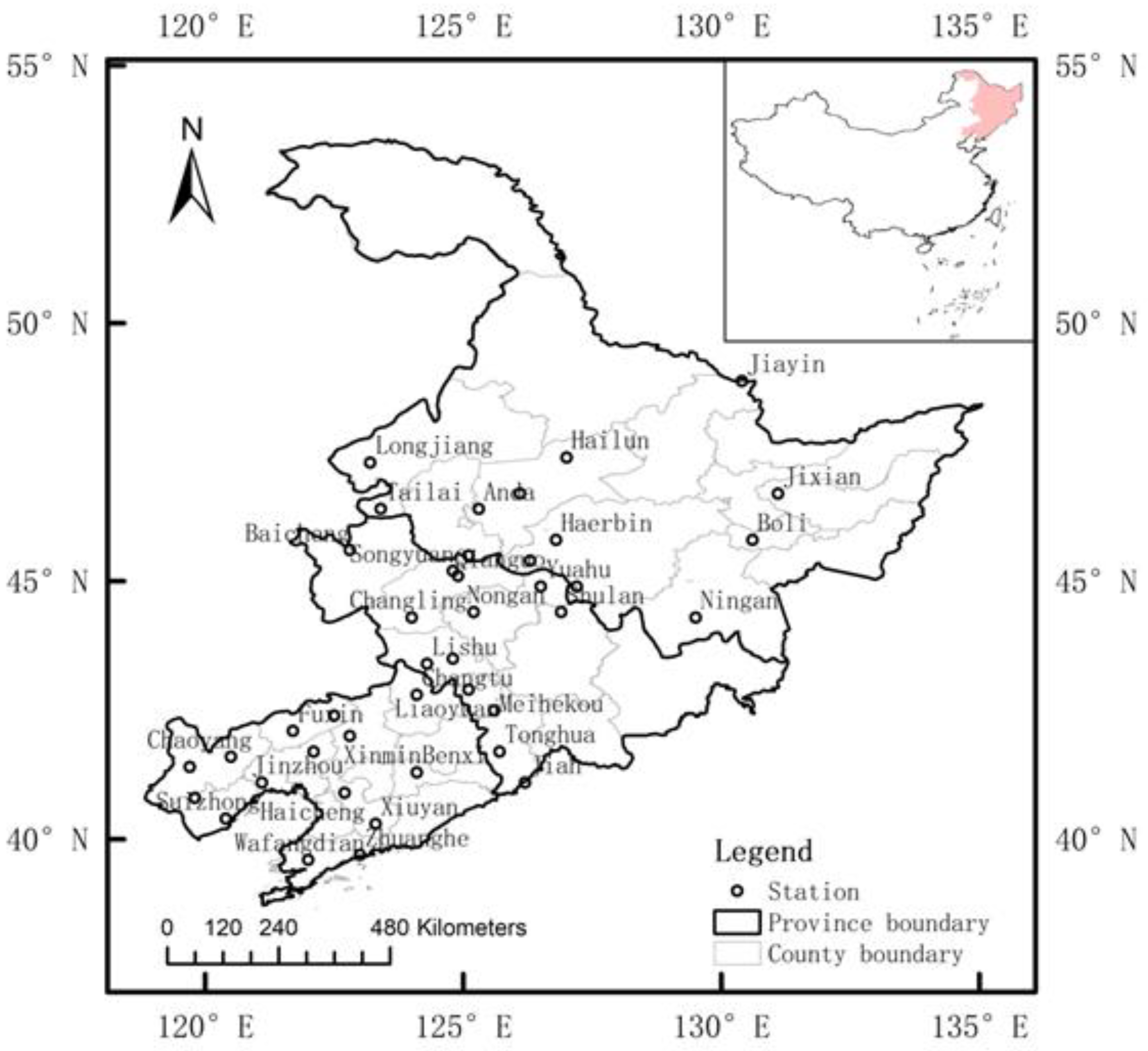


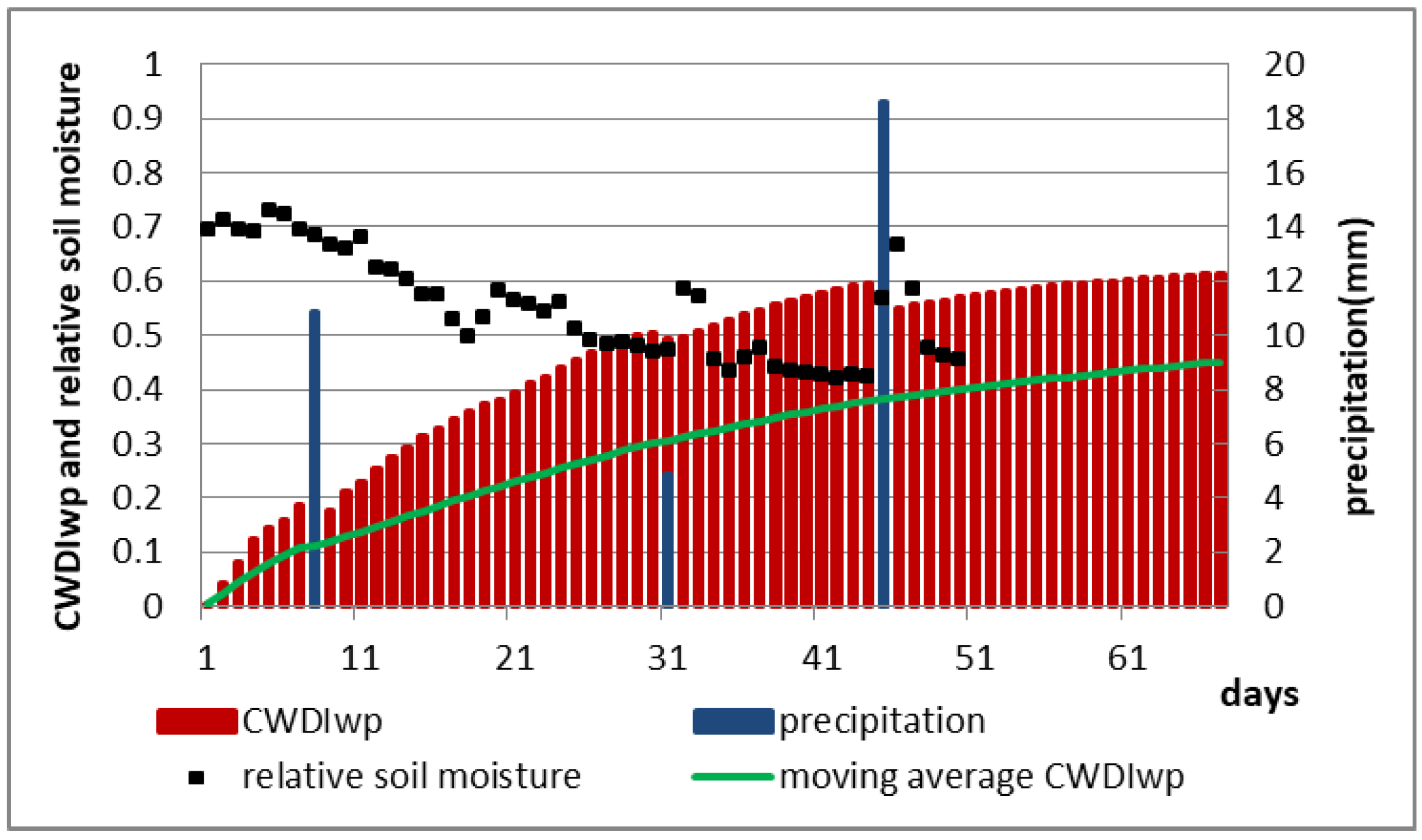
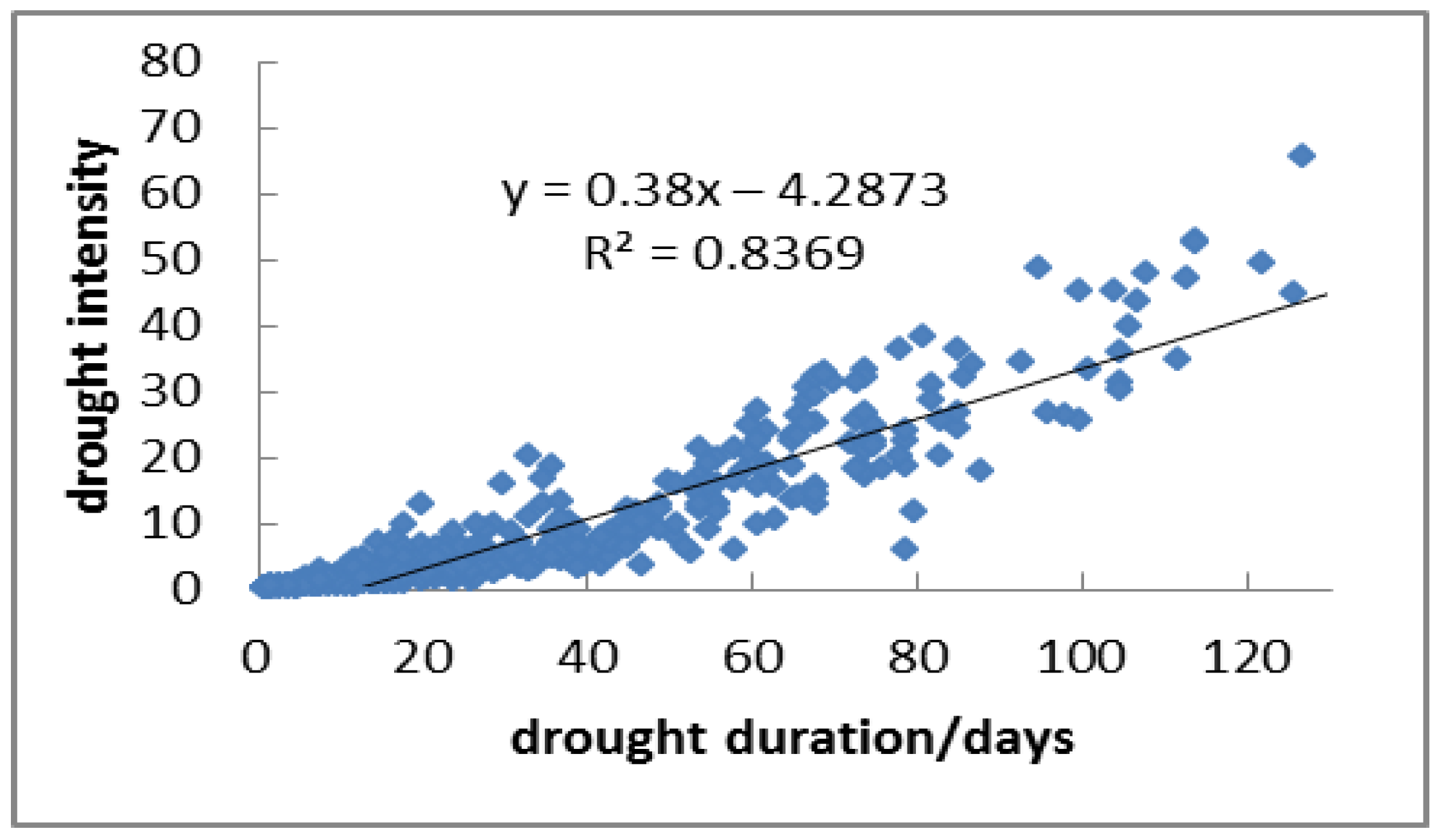
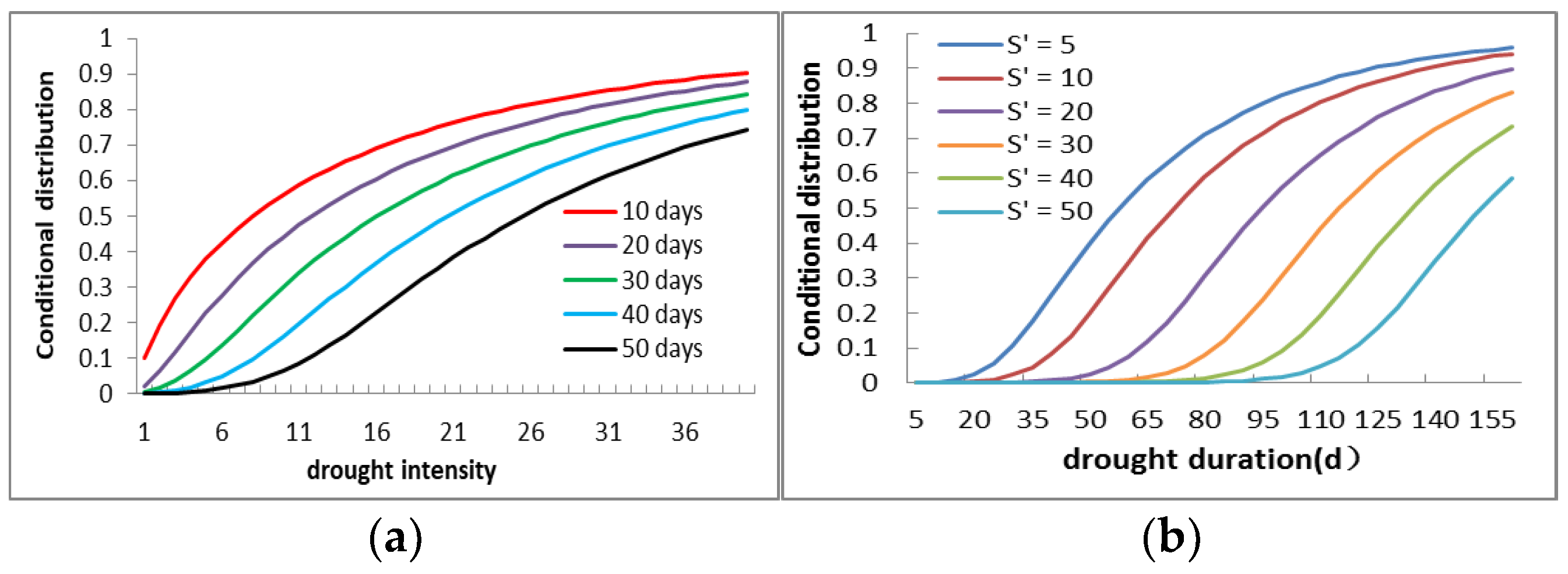
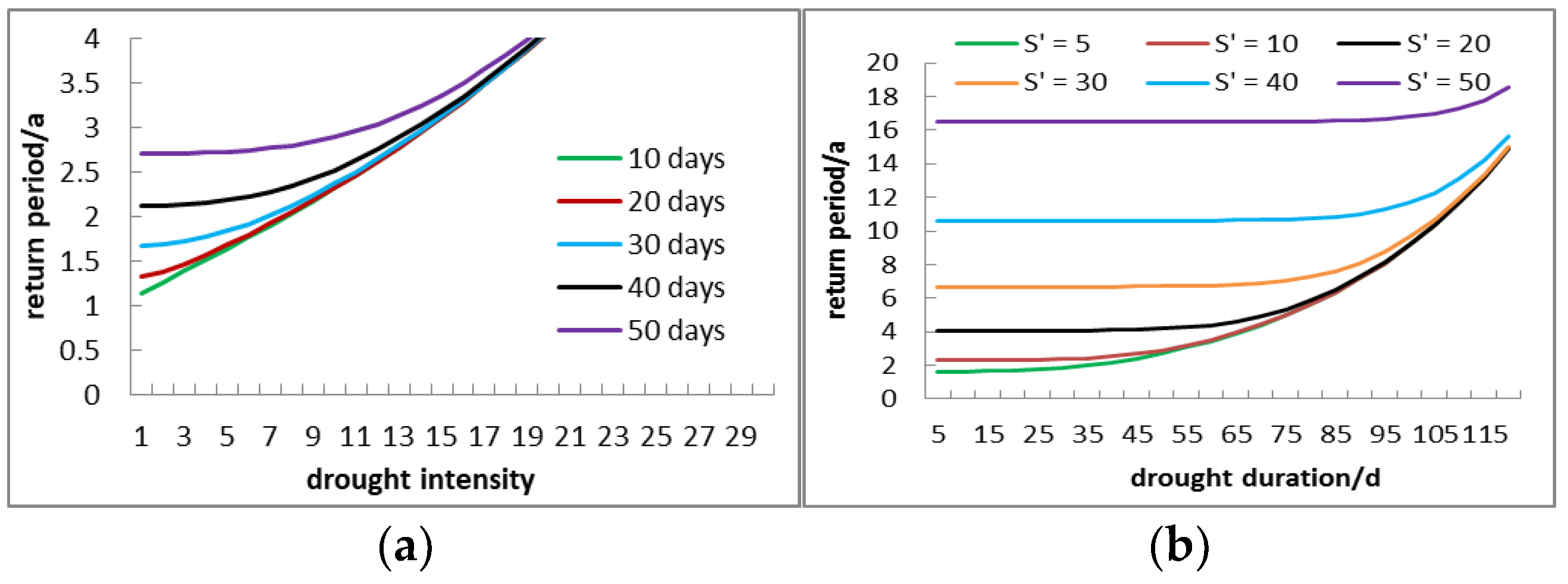
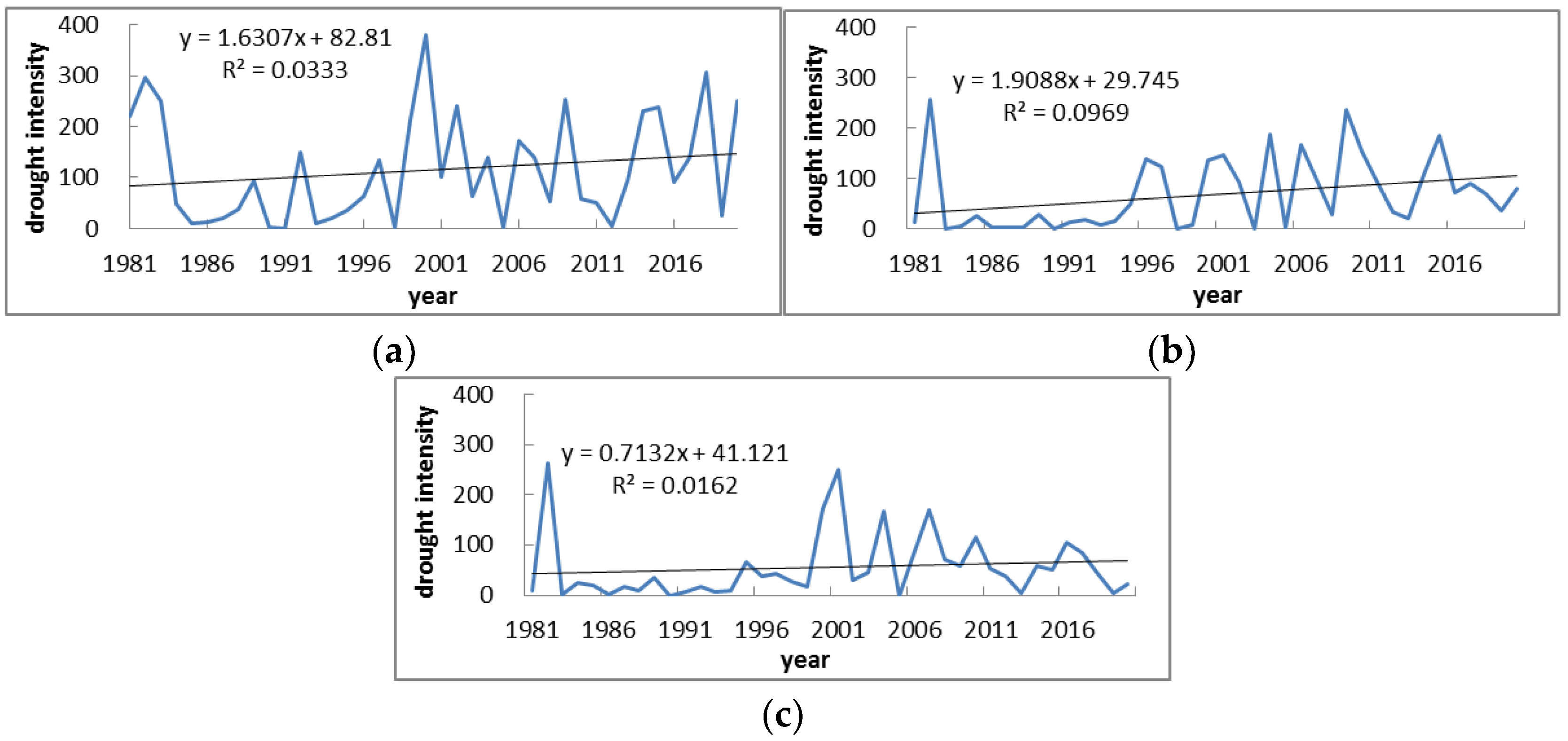



| Drought Severity | D * ≤ 5 | 5 < D ≤ 30 | D > 30 |
|---|---|---|---|
| No drought | S ≤ 0.1 | ||
| Light drought | S > 0.1 | 0 < S ≤ 7.5 | |
| Moderate drought | S > 7.5 | 0 < S ≤ 15 | |
| Severe drought | 15 < S ≤ 30 | ||
| Extreme drought | S > 30 |
| Marginal Distribution | Probability Density Function | Parameter |
|---|---|---|
| γ-distribution | ||
| Lognormal distribution | ||
| Wilson distribution | ||
| Exponential distribution | ||
| Normal distribution | , sample mean values , sample mean errors |
| Copula Function | Copula Distribution Function | Parameter Ranges |
|---|---|---|
| Clayton | ||
| Frank | ||
| Galambos | ||
| Gumbel-Hougaard | ||
| Plackett |
Publisher’s Note: MDPI stays neutral with regard to jurisdictional claims in published maps and institutional affiliations. |
© 2022 by the authors. Licensee MDPI, Basel, Switzerland. This article is an open access article distributed under the terms and conditions of the Creative Commons Attribution (CC BY) license (https://creativecommons.org/licenses/by/4.0/).
Share and Cite
Zhang, S.; Wang, P.; Wang, D.; Zhang, Y.; Ji, R.; Cai, F. Identification and Risk Characteristics of Agricultural Drought Disaster Events Based on the Copula Function in Northeast China. Atmosphere 2022, 13, 1234. https://doi.org/10.3390/atmos13081234
Zhang S, Wang P, Wang D, Zhang Y, Ji R, Cai F. Identification and Risk Characteristics of Agricultural Drought Disaster Events Based on the Copula Function in Northeast China. Atmosphere. 2022; 13(8):1234. https://doi.org/10.3390/atmos13081234
Chicago/Turabian StyleZhang, Shujie, Ping Wang, Dongni Wang, Yushu Zhang, Ruipeng Ji, and Fu Cai. 2022. "Identification and Risk Characteristics of Agricultural Drought Disaster Events Based on the Copula Function in Northeast China" Atmosphere 13, no. 8: 1234. https://doi.org/10.3390/atmos13081234
APA StyleZhang, S., Wang, P., Wang, D., Zhang, Y., Ji, R., & Cai, F. (2022). Identification and Risk Characteristics of Agricultural Drought Disaster Events Based on the Copula Function in Northeast China. Atmosphere, 13(8), 1234. https://doi.org/10.3390/atmos13081234







